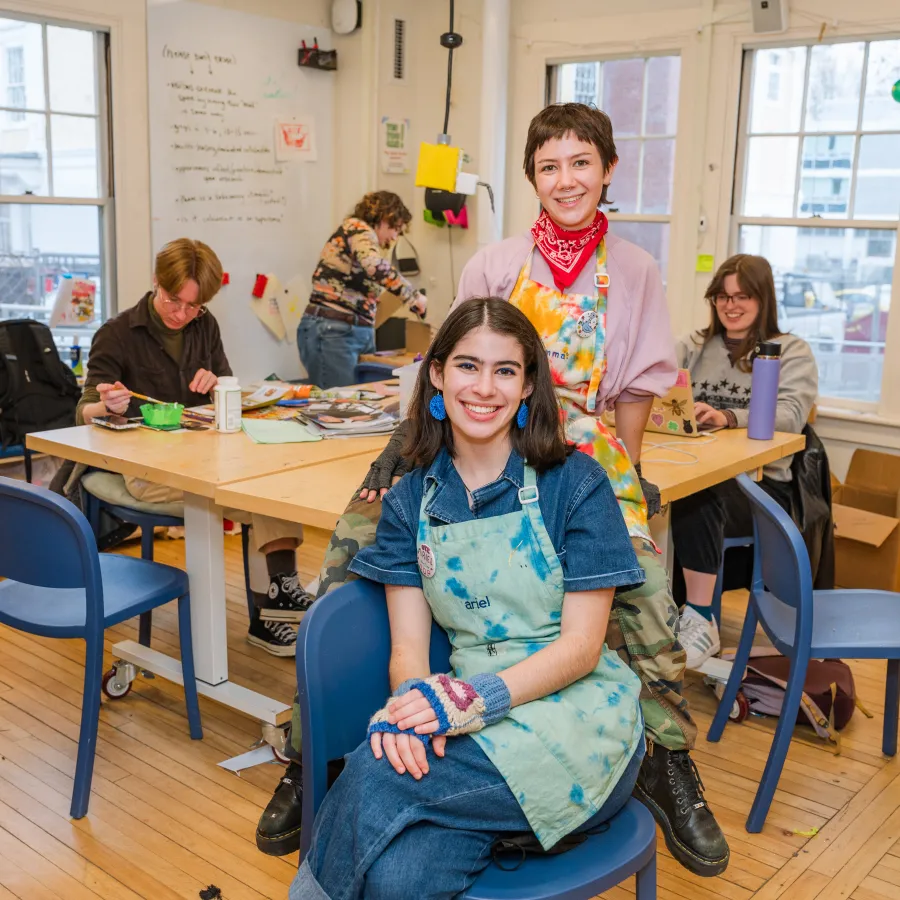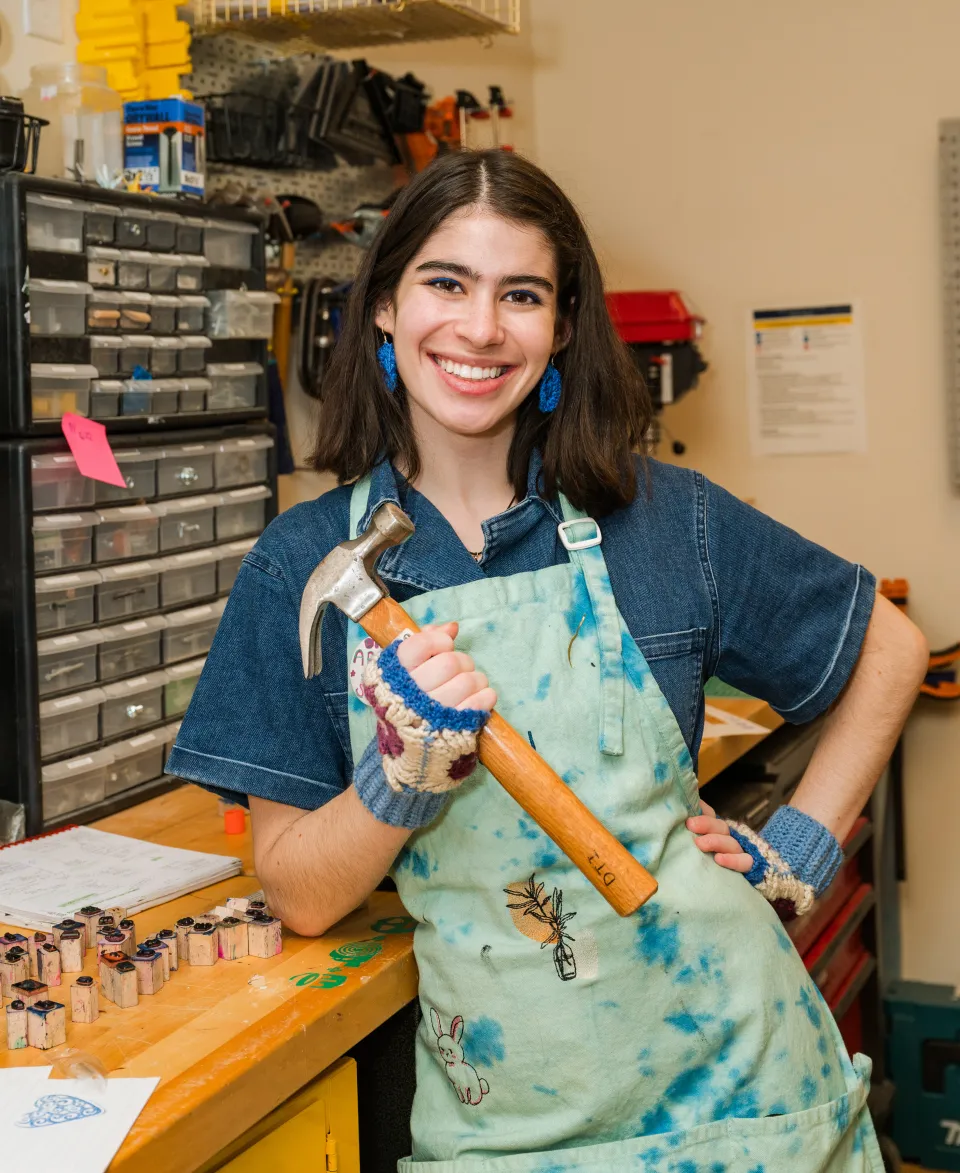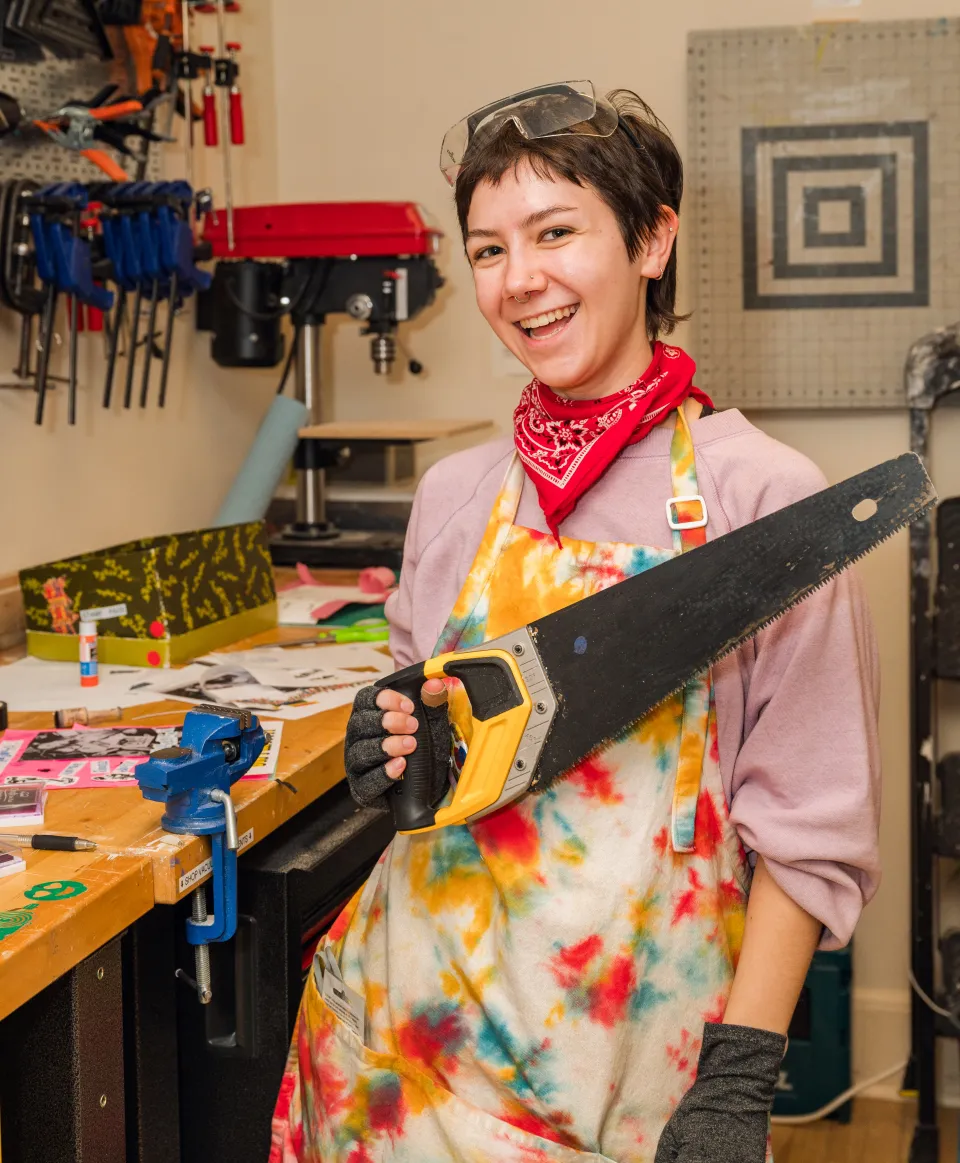Designing for All
Research & Inquiry
Students are using design thinking to help bring about disability justice
Photograph by Shana Sureck
Published December 12, 2023
At Smith’s Design Thinking Initiative headquarters in Capen Annex, the signs tell the story.
Colorful placards posted throughout the building declare “Yes You Can!” followed by specifics—everything from, “Ask staff for help, even if we look busy,” to “Explore the upstairs studio,” to “Eat these snacks and use the dishes.”
Created by Student Studio Design partners who staff the annex, the signs are among the small-but-mighty strategies aimed at ensuring that the space is welcoming to people of all abilities. Others include putting samples of items on the outside of storage cabinets as visual aids, and offering to bring the studio’s sewing machines and other equipment to students with limited mobility.
These efforts reflect an emerging commitment to “design justice”—defined on the initiative’s website as the practice of giving “those most affected by a challenge agency in the process of designing solutions.”
Ariel Benjamin ’25 says that approach is what has kept her involved in design thinking since her first weeks on campus. A Studio Design Partner and among the first to enroll in the college’s new Interdisciplinary Making concentration, Benjamin conducted research over the summer comparing accessibility at Smith’s Design Thinking studio to makerspaces on other college campuses.
Her survey convinced her that “the invisible barriers, like people being afraid to ask permission to do things” are as important to address as physical access to the space. “Design is a great way to address disability justice,” notes Benjamin, who is co-founder of Dis-Organizing, an advocacy group for Smithies with disabilities. “We want to be about community, not gatekeeping.”
Fellow Studio Design Partner Emma Merchant ’24 is working on a project focused on improving outdoor seating on campus. Last fall, Merchant conducted a public brainstorming session and is now creating seating designs aimed at making Smith’s physical grounds a source of community.
“I don’t want students to feel isolated,” Merchant says. “I want us to have comfortable and accessible community spaces. That’s why I’m designing campus seating.”
While human-centered design is integral to the philosophy of design thinking, the DTI’s student partners are extending that framework by identifying barriers that keep people with disabilities from feeling welcome in makerspaces—and other spaces on campus.
“Ariel and Emma have brought a particular focus to accessibility this year,” says Emily Norton, director of the Design Thinking Initiative. “By taking action to redesign campus spaces and infrastructure in a way that supports historically unaddressed needs, they are improving our whole community.”
Here’s what Benjamin and Merchant had to say about their research projects.
Ariel Benjamin ’25
Major: Jewish Studies
Project title: Accessibility in the Making
“When I walked into Capen Annex my first week at Smith, a Studio Design Partner greeted me by asking, ‘Are you a maker?’ And that title so resonated with me. This was after my gap year when I was in the hospital and spent a lot of time in doctors’ office waiting rooms, so I picked up crafts like embroidery. That’s why making is so important to me. I was able to find a sense of autonomy through the process of making and creating. I have disabilities and have encountered many accessibility barriers at Smith. But coming to the DTI, I immediately felt a sense of belonging and independence.
“For my project, I did an accessibility audit—a full walk-through of the Design Thinking Initiative. I evaluated physical barriers and more invisible barriers, like people feeling as though they need to ask permission to do things. I looked at student survey answers about their sense of agency and how identities are reflected in the space. This past summer, I toured five makerspaces at other colleges and I presented at two conferences on accessibility within makerspaces.
“Some of the other spaces were bigger and had more equipment than ours. And we do have physical barriers here—the stairs [to the second floor] are the biggest. But I also found some makerspaces were limited to just engineering students or just art students. At Smith’s DTI, everyone is welcome. We also offer more workshops and open hours than what I saw in some other places. A lot of people do their engineering and art projects here, but they also come to make keychains for clubs or Sib Week gifts or Mother’s Day presents. We’re probably the most equipped center to be able to adapt to people’s needs and their individual design goals.
“People with disabilities need to feel they belong in the DTI—and in the maker movement—because there are already so many other accessibility barriers that exist. This semester, we’ve made changes to our website, finally got an automatic door opener installed, and we’re currently working to make the power tool area [of the studio] more accessible. We’ve put up proficiency charts so people will know the right person to contact when they need help with equipment. I’ve coordinated bringing one of the speakers I met at one of the conferences to campus to do a workshop. They work with disabled people and young children in makerspaces and lead workshops on providing accommodations within woodshops and other creative spaces. Making is often assumed to be not accessible. I’m very passionate about using design to change that.”
Emma Merchant ’24
Major: Studio Art
Project title: Building Community and Benches
“I started seeking a diagnosis [for their condition] during my first year at Smith after years of being dismissed by doctors. I had assumed that everyone’s body worked like mine, that we were all in constant pain; that I was simply whiny. Then the pandemic hit, and I took a gap year. As I got to know my body better and connected with others who manage similar conditions, I began to notice how much worse my condition was made by the outside world. Very few spaces are designed to be hospitable or comfortable, and Smith is no exception. I returned to campus much more attuned to disability than I had previously been.
“I also was more aware that there were very few non-academic spaces for students to hang out in at Smith, and these spaces are largely inaccessible. I felt isolated and frustrated. In the spring, I approached Emily Norton to ask if she would collaborate with me to secretly [unofficially] install benches across campus. From there, my project grew into something more expansive and joyful than I ever could have imagined.
“I’ve done a lot of archival research to figure out why Smith was built the way it was. I truly believe that part of the reason so many students feel isolated is because the campus was designed to be isolating. The design was meant to drive students into Northampton to meet men, or into their houses to remain under supervision. Smith has a long history of wanting to empower students, but only in ‘respectable’ ways. That tension is present in all areas of campus life.
“Last fall I led a ‘Design Share-tte’ and invited individuals from across campus—staff, professors, traditional students, Ada Comstock scholars—to take a look at my research and design a ‘dream bench’ for their individual needs. Since then, I’ve been working with Emily to create designs that incorporate what our community asked for—including fun and play. Over J-term and spring semester I’ll be working with the woodshop and collecting feedback. My ultimate goal is to build seating areas that encourage people to play, connect with others, and rest as they need to.
“Creating a welcoming environment is a part of disability justice and accessibility as well. Designing seating around disability justice and community has been a huge undertaking, but it’s connected me to so many supportive and amazing people—I wouldn’t have it any other way!”
Photos By Shana Sureck



